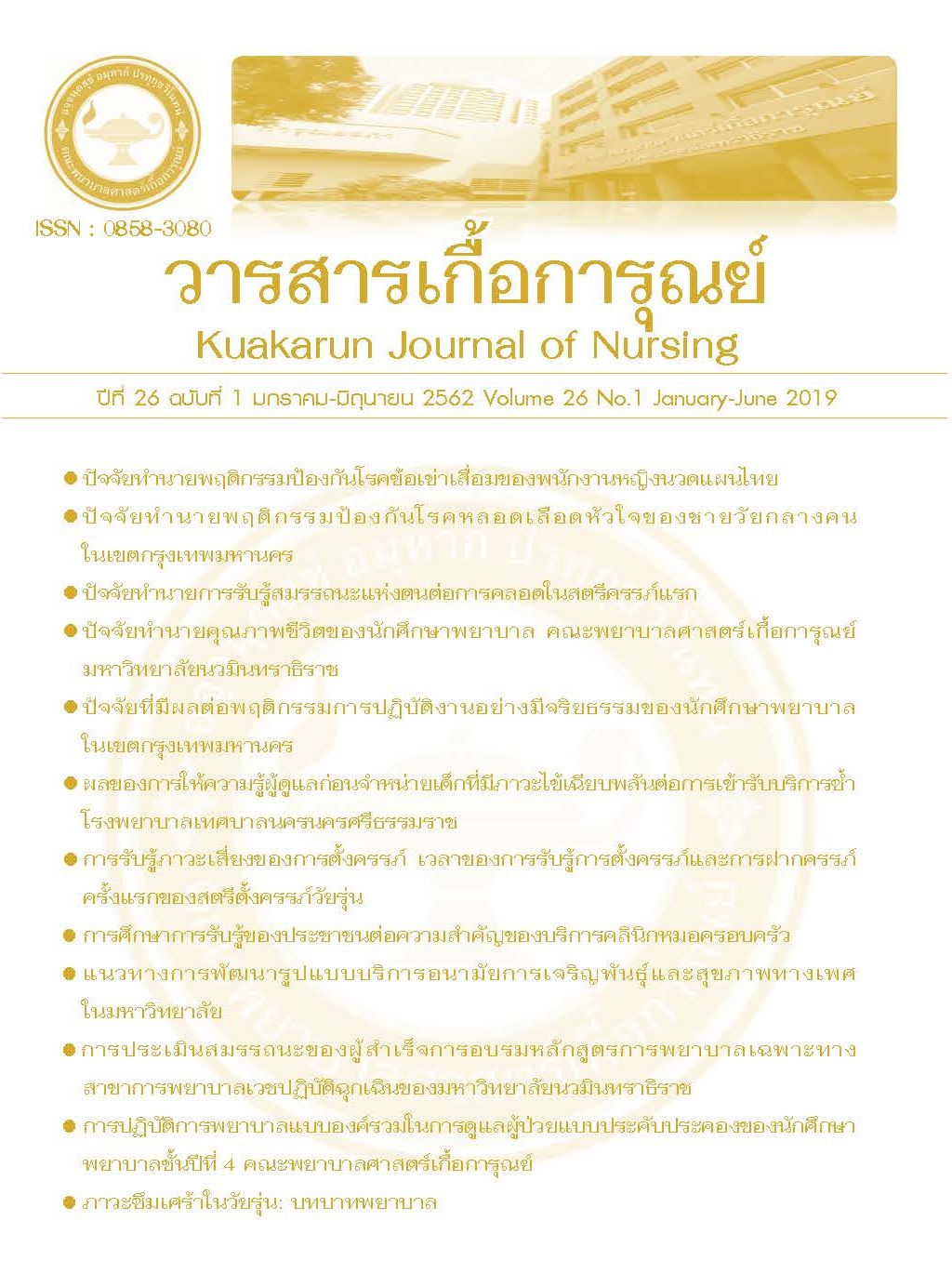การประเมินสมรรถนะของผู้สำเร็จการอบรมหลักสูตรการพยาบาลเฉพาะทาง สาขาการพยาบาลเวชปฏิบัติฉุกเฉิน ของมหาวิทยาลัยนวมินทราธิราช
คำสำคัญ:
การประเมินสมรรถนะ, ผู้สำเร็จการอบรม, หลักสูตรการพยาบาลเฉพาะทางสาขาการพยาบาลเวชปฏิบัติฉุกเฉินบทคัดย่อ
การพัฒนาสมรรถนะของพยาบาลที่ปฏิบัติงานอุบัติเหตุและฉุกเฉินจำเป็นต้องมีความรู้ความสามารถและศักยภาพด้านการพยาบาลฉุกเฉิน การประเมินติดตามสมรรถนะของพยาบาลเฉพาะทางสาขาเวชปฏิบัติฉุกเฉินในระยะยาวจึงมีความจำเป็น การวิจัยครั้งนี้เป็นการวิจัยเชิงบรรยายเพื่อศึกษาสมรรถนะการพยาบาลฉุกเฉินของผู้สำเร็จการอบรมหลักสูตรการพยาบาลเฉพาะทางสาขาพยาบาลเวชปฏิบัติฉุกเฉิน (หลักสูตรเวชปฏิบัติฉุกเฉิน) รุ่นที่ 1 มหาวิทยาลัยนวมินทราธิราชในระยะก่อนการอบรม ภายหลังการอบรม ติดตามผลระยะ 1 เดือนและ 3 เดือนตามลำดับ ประชากรที่ใช้ในการวิจัยจำนวน 83 คน ได้แก่ กลุ่มผู้สำเร็จการอบรม (หลักสูตรเวชปฏิบัติฉุกเฉิน) จำนวน 38 คน กลุ่มพยาบาลตึกอุบัติเหตุและฉุกเฉินจำนวน 25 คน และกลุ่มหัวหน้าตึกอุบัติเหตุและฉุกเฉินจำนวน 20 คน เครื่องมือที่ใช้เป็นแบบสอบถามสมรรถนะการพยาบาลฉุกเฉิน มีความตรงแบบดัชนีความสอดคล้อง เท่ากับ 0.8 ค่าความเที่ยงแบบสัมประสิทธิ์แอลฟาของคอนบาคเท่ากับ 0.9 วิเคราะห์ข้อมูลโดยสถิติบรรยาย ทดสอบความแปรปรวนทางเดียวและทดสอบความแปรปรวนทางเดียวแบบวัดซ้ำ
ผลการวิจัยพบว่า (1) จากการประเมินตนเองของผู้สำเร็จการอบรม ก่อนการอบรมการพยาบาลฉุกเฉิน ผู้สำเร็จการอบรมมีสมรรถนะการพยาบาลฉุกเฉินในภาพรวมอยู่ในระดับปานกลาง ( = 3.47, S.D= 0.49) ด้านที่มีค่าเฉลี่ยสูงที่สุด คือการช่วยฟื้นคืนชีพ (
= 3.57, S.D= 0.61 ) สมรรถนะการพยาบาลฉุกเฉินภายหลังการอบรมและติดตามผล 1 เดือนอยู่ในระดับมาก (
= 4.45, S.D= 0.35 และ
= 4.27, S.D= 0.24) ด้านที่มีค่าเฉลี่ยสูงที่สุดคือการช่วยฟื้นคืนชีพ (
= 4.53, S.D= 0.38,
= 4.38, S.D= 0.36) และเมื่อติดตามผล 3 เดือน สมรรถนะโดยรวมอยู่ในระดับมากที่สุด (
= 4.55, S.D= 0.36) ด้านที่มีค่าเฉลี่ยสูงที่สุดคือการช่วยฟื้นคืนชีพ (
= 4.78, S.D= 0.36) สมรรถนะการพยาบาลฉุกเฉินโดยติดตามผลระยะ 1 เดือนและ 3 เดือนพบว่าในภาพรวมอยู่ในระดับมาก (
= 4.26, S.D= 0.35 และ
= 4.41, S.D= 0.38) (2) สมรรถนะการพยาบาลฉุกเฉินของผู้สำเร็จการอบรมในระยะก่อนการอบรม ภายหลังการอบรม ติดตามผล 1 เดือนและ 3 เดือน มีความแตกต่างกันอย่างมีนัยสำคัญทางสถิติ (P < 0.05) (3) เมื่อติดตามผลระยะ 1 เดือนและ 3 เดือนภายหลังการอบรม ตามความคิดเห็นของผู้สำเร็จการอบรมเอง พยาบาลวิชาชีพ และหัวหน้าหอผู้ป่วย สมรรถนะการพยาบาลฉุกเฉินของผู้สำเร็จการอบรม ไม่มีความแตกต่างกันอย่างนัยสำคัญทางสถิติ (P < 0.05)
จากผลการวิจัยนี้มีข้อเสนอแนะว่าการประเมินสมรรถนะพยาบาลฉุกฉินของผู้สำเร็จการอบรมควรประเมินเป็นระยะๆ เพื่อนำไปพัฒนา (หลักสูตรเวชปฏิบัติฉุกเฉิน) ให้คงรักษาสมรรถนะตามที่ต้องการ ควรมีการศึกษาติดตามประเมินสมรรถนะของผู้สำเร็จการอบรมในเชิงคุณภาพเพื่อให้ได้ข้อมูลที่ลึกซึ้งมากยิ่งขึ้นเพื่อพัฒนาคุณภาพการพยาบาลในการดูแลผู้ป่วยฉุกเฉินได้อย่างถูกต้องปลอดภัยและมีประสิทธิภาพต่อไป
เอกสารอ้างอิง
มาลี คำคง (2557).การพัฒนาพยาบาลสู่คุณภาพการบริการในงานอุบัติเหตุ-ฉุกเฉิน. วารสารเครื่อข่ายวิทยาลัยพยาบาลและการสาธารณสุขภาตใต้, 1(1), 71-84.
ปรียาวรรณ วิบูลย์วงศ์ และธนาภา ฤทธิวงษ์ (2560). การประเมินสมรรถนะของผู้สำเร็จการอบรมหลักสูตรการพยาบาลเฉพาะทางสาขาการพยาบาลฉุกเฉิน วิทยาลัยพยาบาลบรมราชชนนี กรุงเทพ. วารสารวิทยาลัยพยาบาลบรมราชชนนี กรุงเทพ, 33(2), 135-145.
สถาบันการแพทย์ฉุกเฉินแห่งชาติ (2558). รายงานประจำปี 2558 สถาบันการแพทย์ฉุกเฉินแห่งชาติ. นนทบุรี: สถาบันการแพทย์ฉุกเฉิน.
ศิริอร สินธุรวมพร คงกำเนิด และกุลระวี วิวัฒนชีวิน (2557) การศึกษาปัจจัยที่มีความสัมพันธ์กับการปฏิบัติการการแพทย์ฉุกเฉินของพยาบาลวิชาชีพ. วารสารวิทยาลัยพยาบาลบรมราชชนนี นครราชสีมา, 20 (2). 33-45.
Chen, S,S., Chen, J.C., Ng, C.J., Chen, P.L., Lee, P.H., & Chang, W.Y. (2010). Factors that influence the accuracy of triage nurses' judgement in emergency departments. Emergency Medicine Journal, 27(6), 451-5.
Gerdtz, M. F., Weiland, T. J., Jelinek, G. A., Mackinlay, C., & Hill, N. (2012). Perspectives of emergency department staff on the triage of mental health‐related presentations: Implications for education, policy and practice, Emergency medicine Australia, 24(5), 492-500.
KozaMani A., Kapadochos, T., & Kadda, O. (2012). Factors that influence nursing staff attitudes toward initiating CPR and in nursing an automatic external defibrillator when outside of a hospital. Journal of Health Science, 6(1), 88-101
World health organization. (2013). Global Status Report on the Road Safety. Retrieve from https://www.who.int/violence_injury_prevention/road_safety_status/2013/en/















